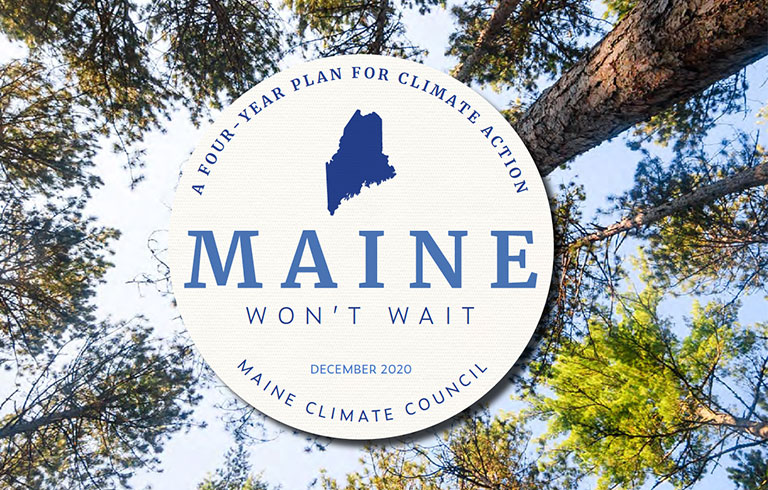While much of coastal Maine struggled with power outages and flooding as a powerful early winter storm unleashed strong winds and heavy rain—all on top of a global pandemic—leaders of the Maine Climate Council marked December 1, 2020 by delivering its groundbreaking climate action plan to Governor Janet T. Mills.
“Maine Won’t Wait, A Plan for Climate Action” presents a bold set of strategies that will put Maine on a trajectory to reduce carbon emissions by 45% by 2030 and at least 80% by 2050, all while preparing Mainers to respond to our rapidly changing environment.
Maine’s coastal and island communities are already experiencing the impacts of climate change (and here and here and here and here). Community and industry leaders recognize that they need resources, support, and action from beyond their “wheelhouse” to adapt to a changing climate and do their part to reduce carbon emissions. State leadership is coming, not a moment too soon, to bolster local efforts underway.
The plan will undoubtedly distinguish Maine nationally and internationally for its commitments, but what will it mean for local leaders here along the coast? And how will the Island Institute step up to bring these recommendations to life?
The plan:
- Sets a sea level rise planning target for 2050: 1.5 feet
- Identifies the huge cost to residents and businesses of not addressing sea level rise and storm surge over the next 30 years: $17.5B and 21,000 jobs lost
- Recognizes broadband infrastructure as a foundational issue of equity
- Makes it easier for marine businesses to access information, resources, and tools to reduce carbon pollution and adapt to a changing environment
- Explicitly includes ferries as part of the state’s work to accelerate the electrification of the transport sector
- Prioritizes meaningful consultation with stakeholders, including Maine’s fishing industry, in the development of offshore wind
- Commits to providing robust technical assistance and funding to communities to implement the plan
The climate action plan is significant not only because of the issues it tackles, but the way in which the plan itself was developed. As an organization which believes strongly that “the outcome is only as good as the process that led to it” and that “the smartest person in the room is the room itself,” we believe that the plan was built in a way that will increase its long-term durability and impact.
More than 230 Mainers, representing different geographies, industries, and political perspectives, engaged in the working group process. As part of their three-year appointments, Council and working group members will continue to engage in this work, reviewing progress, troubleshooting, and recommending actions that will deepen the State’s leadership. This is not a case of “set it and forget it” or a “report on the shelf.”
Importantly, the plan reflects the State’s growing commitment to equity. The University of Maine’s Mitchell Center, with input from a subcommittee that included the Island Institute’s Chief Community Development Officer Suzanne MacDonald, was tapped to develop an equity framework for evaluating recommendations with an eye towards who might benefit and who might be unintentionally burdened or left behind.
Rural communities are considered in the framework as a “geographic vulnerability.” The Institute’s work with energy efficiency work in rural communities, for example, shows why it’s important to design energy efficiency programs that meet the specific challenges of rural communities, insights that we presented to one of the working groups. The plan’s attention to equity and the inclusion of rural, natural-resource dependent communities is a major step towards cementing the idea that rural communities matter and that policy can be designed with rural communities in mind.
As we collectively took a moment (just a moment) to exhale and let ourselves express gratitude and joy for a job well done on December 1st, it was impossible to stop our minds from turning back to implementation and the work at hand. Leveraging the insights that our four staff members gained from participating in the Council’s working groups and subcommittees, and reflecting on the State’s evolving implementation plan, the Island Institute is investing in a series of strategies to bring the plan’s recommendations to life.
Our work in the months ahead will demonstrate that the plan’s recommendations are actionable and scalable. We’ll do this through pilot projects that focus on areas where climate intersects with some of the most defining elements of the Maine coast—the marine economy, islands, and our waterfront infrastructure. We will draw on our long history of enhancing capacity in some of the state’s smallest communities, as well as on existing and emerging partnerships, to help the coast respond to—and even lead on—climate change. We are committed to building off of the State’s equity framework to ensure that underrepresented and overburdened Mainers are included in and benefit from our work.
As the storm’s rains and winds subsided and the sun rose on a brisk morning on December 2nd, we ventured out to survey the damage. We saw utility crews lining many of the streets in Midcoast, and just like the climate action plan’s release the day before left us thinking about the work ahead, they were readying equipment, dispatching teams, and rolling up their sleeves.
A quiet reminder to us all that it’s time to get to work.
To learn more about our work with the Maine Climate Council, visit our Climate Council page here.


